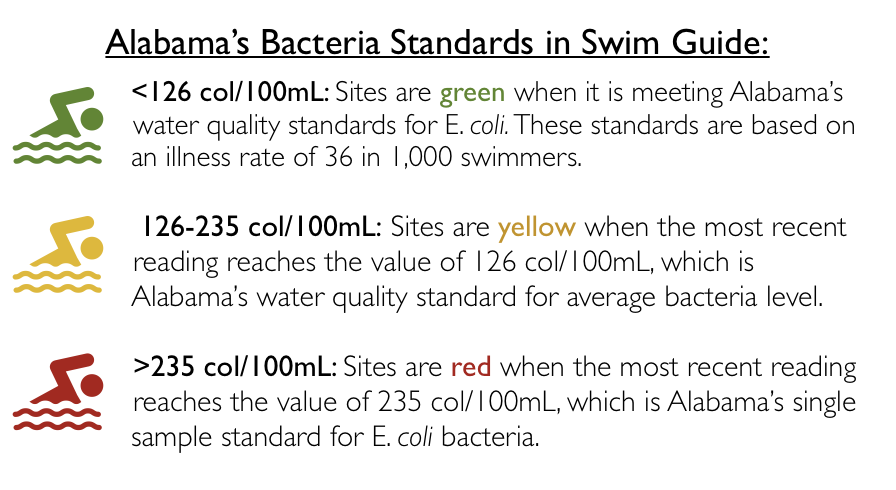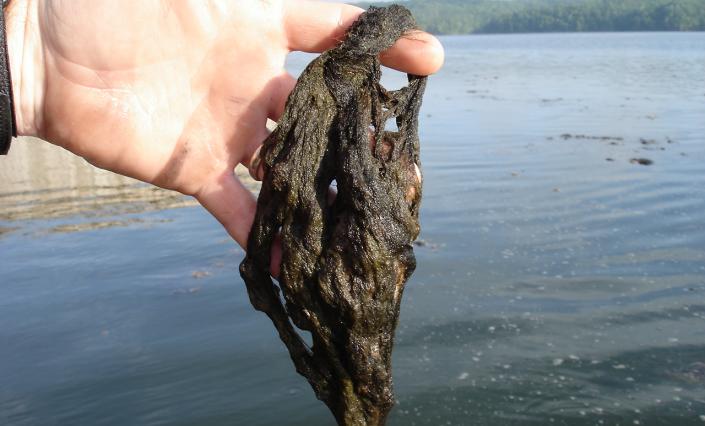Each summer we call on swimmers & boaters to “get the skinny before they dip”. But what about fishermen?
When we are out testing the first few weeks of Swim Guide, we see a lot of folks on the water. And they aren’t swimmers. Before school lets out & the water warms up fishermen are the ones we are sharing the docks with.
Whether you are a swimmer, a boater, or fishermen it’s safe to say that everyone should want to be aware if the water they are recreating in is contaminated.
But, if you are a fishermen there are a few other resources that Swim Guide can provide you for a successful and safe day out on the water.
5 ways you can “Get the Skinny Before You Cast”
1
Bacteria
Most people know that E. coli can make you very sick. When E. coli levels are high, the chance of coming in contact with this bacteria increases greatly.
In recent studies with water of a high E. coli concentration, bacteria was found on hands of fishermen who had not yet caught any fish. 78% of fishermen had E. coli on their hands after just dipping their hands in the water and 100% of fishermen had traces of E. coli on their hands at some point during their fishing trip.

3 ways to prevent infection:
- Check Swim Guide for E. coli levels before you cast.
- Wash your hands before and immediately after fishing especially before eating a meal.
- Cook your catch all the way to kill E. coli bacteria.
2
Dissolved Oxygen
Dissolved oxygen (DO) is the amount of O2 found in the water. Just like humans, fish need oxygen to function. Different species of fish require different amounts of dissolved oxygen, but most river and lake fish need 4-15mg/L. More sensitive fish require a certain level of dissolved oxygen in order to reproduce. If the DO level is too low, some fish species will not be able to successfully spawn.

What this means for me:
When the dissolved oxygen levels in a water source drop the fish may become sluggish due to the lack of oxygen they are receiving and if the level drops too low there will be an increase in fish mortality rates due to the lack of oxygen available.
When fishing in an area with low DO levels:
Since the fish are not capable of moving quickly or for long periods of time, use slow moving bait or more static bait.
3
Turbidity
Turbidity is the measurement of water clarity. Turbid waters are caused by suspended particles of soil, organic matter, rocks, or other sediment in the water. Turbidity levels are important to know because it helps us understand how far down sunlight is penetrating the water, which is crucial to the plant and algae growth.


Because these organisms are the beginning of the aquatic food chain, they are essential to all aquatic life. When turbidity levels are high, plants cannot receive the sunlight they need to grow and reproduce properly. Sight-feeding fish, like largemouth bass, will struggle finding and capturing food due to the lack of clarity in the water. High levels of turbidity also can prevent fish from seeing on-coming predators, and can increase mortality rates.
What you can do to prevent turbid fishing holes:
- Line garden areas and landscaping areas to prevent sediment runoff.
- Use less fertilizers to prevent excess nitrogen and phosphorous in waterways which leads to excess algae growth.
When fishing in these areas:
- Use more noticeable bait to help catch the fish’s attention.
- Move to clearer areas to find more fish.
4
Water Temperature
The spawning period in fish responds accordingly to the temperature of the water. During this part of the season, the water temperatures are varying between 63 degrees and 79 degrees, meaning the fish are generally done with the spawning process and in their post-spawn state. Post-spawn fish are slower and less aggressive, as their bodies are still recovering from the stress of spawning.
What this means for me:
It is important to note that dissolved oxygen levels decrease as temperature increases. If the temperatures become too high in a waterway look for fish in deeper areas where there will be more oxygen.
When fishing in these areas:
- Look for fish in deeper, cooler areas.
- Use easy-to-catch, obvious bait.
5
pH
pH is the measure of how acidic or basic a body of water is. Aquatic organisms require relatively neutral water to survive, so if the water becomes too acidic or too basic, fish mortality will increase. pH outside of the 6.5-9.0 range can cause stress on aquatic organisms and can decrease survival rates for young organisms.


If a water system’s pH becomes extremely high (more basic water) the water can strip off a fish’s slime coat and “chap” it’s skin. This can cause the fish to be more susceptible to harmful bacteria and pollution. Extremely low pH (more acidic water) can cause direct damage to a fish’s eyes, gills, and skin, and can affect the fish’s metabolic waste process, which gets rid of excess nutrients the fish does not need.
When fishing in these areas:
If fishing in an area with a non-neutral pH (around a pH of 7):
- Observe your fish for body damage and note the fish may be more susceptible to bacteria
- Cook your catch thoroughly and completely
- Move to an area with a pH between 6.5-9.0 for more normal fishing habits
Hooked?
Text “SwimGuide” to 844-83 to get Text Message alerts sent to your phone each Friday!
This post was written by:
Abby Swain
Abby is a Junior Urban Environmental Studies major, Biology minor at Birmingham Southern College. Abby spends her free time swimming on BSC’s Swim Team & pledging for Kappa Delta. She has an unhealthy obsession with house plants and loves to spend her free time relaxing and friends.






